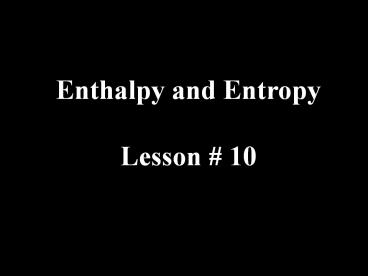Enthalpy and Entropy - PowerPoint PPT Presentation
1 / 25
Title:
Enthalpy and Entropy
Description:
Enthalpy and Entropy Lesson # 10 There are two factors that determine the direction that reactions proceed in. These two factors will also allow you to predict the ... – PowerPoint PPT presentation
Number of Views:68
Avg rating:3.0/5.0
Title: Enthalpy and Entropy
1
Enthalpy and Entropy Lesson 10
2
There are two factors that determine the
direction that reactions proceed in. These two
factors will also allow you to predict the
relative amount of reactants and products at
equilibrium. 1. Reactions tend to proceed
toward minimum enthalpy. Enthalpy is
PE. Reactions tend to go downhill in
enthalpy. Exothermic ?H is ve Downhill
Products Favoured
3
1. Reactions tend to proceed toward minimum
enthalpy. Enthalpy is PE. Reactions tend to go
downhill in enthalpy. Endothermic ?H is
ve Uphill
Reactions Favoured
4
2. Reactions tend to go toward maximum entropy.
Watch Simulation Entropy is randomness or a
measure of how spread out, shuffled up, or
broken up the system is. Less Entropy More
Entropy H2O(s) H2O(l) H2O(l) H2O(g)
NaCl(s) NaCl(aq) N2O4(g) 2NO2(g) glas
s broken glass clean room messy room
5
Based on Enthalpy and Entropy describe each
reaction. 1. Zn(s) 2HCl(aq) ? H2(g)
ZnCl2(aq) ?H -252 KJ For entropy- only
look at phase symbols- mainly gases 0 gases 1
gas max entropy- favours products! For
enthalpy draw the PE diagram! The low side is
favoured by enthalpy- products.
Favours the Products. Big
Keq High Yield Goes to Completion
6
Based on Enthalpy and Entropy describe each
reaction. 2. N2O4(g) ? 2NO2(g) ?H 20 KJ
1 gases 2 gases Phase Symbols- max
entropy favours products!
PE Diagram- minimum enthalpy favours reactants
Goes to equilibrium. Keq is about
1
7
Based on Enthalpy and Entropy describe each
reaction. 3. 3C(s) 3H2(g) 45 KJ ?
C3H6(g) 3 gases 1 gas Phase
Symbols- max entropy favours reactants!
PE Diagram- minimum enthalpy favours reactants
Favours the reactants. Little
Keq Low Yield Does not occur
8
4. Here is an easy way to analysis a reaction.
v max entropy v min enthalpy ?
? ? ? ?
9
4. Here is an easy way to analysis a reaction.
v max entropy v min enthalpy v ?
? ? ? ?
10
4. Here is an easy way to analysis a reaction.
v max entropy v min enthalpy v ?
v ? ? ? ?
11
4. Here is an easy way to analysis a reaction.
v max entropy v min enthalpy v ?
v equlibrium ? ? ? ?
12
4. Here is an easy way to analysis a reaction.
v max entropy v min enthalpy v ?
v equlibrium ? v ? ? ?
13
4. Here is an easy way to analysis a reaction.
v max entropy v min enthalpy v ?
v equlibrium ? v v ? ? ?
14
4. Here is an easy way to analysis a reaction.
v max entropy v min enthalpy v ?
v equlibrium ? v v products favoured
? ? ?
15
4. Here is an easy way to analysis a reaction.
v max entropy v min enthalpy v ?
v equlibrium ? v v products favoured v
? ? ?
16
4. Here is an easy way to analysis a reaction.
v max entropy v min enthalpy v ?
v equlibrium ? v v products favoured v v
? ? ?
17
4. Here is an easy way to analysis a reaction.
v max entropy v min enthalpy v ?
v equlibrium ? v v products favoured v v
? reactants favoured ? ?
18
4. Here is an easy way to analysis a reaction.
v max entropy v min enthalpy v ?
v equlibrium ? v v products favoured v v
? reactants favoured v ? ?
19
4. Here is an easy way to analysis a reaction.
v max entropy v min enthalpy v ?
v equlibrium ? v v products favoured v v
? reactants favoured v ? v ?
20
4. Here is an easy way to analysis a reaction.
v max entropy v min enthalpy v ?
v equlibrium ? v v products favoured v v
? reactants favoured v ? v
equlibrium ?
21
4. Here is an easy way to analysis a reaction.
v max entropy v min enthalpy v ?
v equlibrium ? v v products favoured v v
? reactants favoured v ? v
equlibrium ? v v
22
4. Here is an easy way to analysis a reaction.
v max entropy v min enthalpy v ?
v equlibrium ? v v products favoured v v
? reactants favoured v ? v
equlibrium ? v v products favoured
23
4. Describe the change in entropy for an
endothermic equilibrium system.
Maximum entropy Must be on the opposite side of
min enthalpy to get an equilibrium.
Minimum enthalpy
Entropy must increase
24
5. Describe the change in entropy for an
exothermic equilibrium system.
Minimum enthalpy
Maximum entropy
Entropy is decreasing Enthalpy is decreasing
25
Equilibrium is a compromise between the
tendencies toward minimum enthalpy and maximum
entropy.

